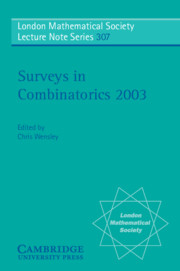Book contents
- Frontmatter
- Contents
- Preface
- W.T. Tutte, 1917–2002
- 1 Decompositions of complete graphs: embedding partial edge-colourings and the method of amalgamations
- 2 Combinatorial schemes for protecting digital content
- 3 Matroids and Coxeter groups
- 4 Defining sets in combinatorics: a survey
- 5 Finite projective planes with a large abelian group
- 6 Algorithmic aspects of graph homomorphisms
- 7 Counting lattice triangulations
- 8 Partition regular equations
- 9 Kostka–Foulkes polynomials and Macdonald spherical functions
W.T. Tutte, 1917–2002
Published online by Cambridge University Press: 05 May 2013
- Frontmatter
- Contents
- Preface
- W.T. Tutte, 1917–2002
- 1 Decompositions of complete graphs: embedding partial edge-colourings and the method of amalgamations
- 2 Combinatorial schemes for protecting digital content
- 3 Matroids and Coxeter groups
- 4 Defining sets in combinatorics: a survey
- 5 Finite projective planes with a large abelian group
- 6 Algorithmic aspects of graph homomorphisms
- 7 Counting lattice triangulations
- 8 Partition regular equations
- 9 Kostka–Foulkes polynomials and Macdonald spherical functions
Summary
Bill Tutte will take his place in history for two reasons. First, as part of the now-famous codebreaking team at Bletchley Park, he made a significant individual contribution to the outcome of the Second World War. Secondly, he formulated and proved many of the theorems that form the foundations of Graph Theory. In both cases his achievements resulted from very deep insights into matters that, at first sight, might be thought simple. In 1977 Paul Erdős recalled [13]:
I first heard about Tutte in early September 1939 …. But of the real powers I only learned later. T. Gallai and I as freshmen in 1930 took the course on graph theory by D. Kőnig – he mentioned the conjecture of Tait and the extension of Petersen's theorem on factorisation of graphs as important outstanding problems – we tried both unsuccessfully. As is well known, Tutte settled both problems – and many others.
William Thomas Tutte was born on May 14, 1917 at Fitzroy House, a horseracing establishment in Newmarket, England. Around 1921 the family settled in Chevely, a village near Newmarket, where his father was gardener at the Rutland Arms Hotel. He attended the village school until, at the age of 11, he won a scholarship to the Cambridge and County High School. The school was 15 miles from his home and the daily journey was difficult, but well worth the effort.
- Type
- Chapter
- Information
- Surveys in Combinatorics 2003 , pp. 1 - 6Publisher: Cambridge University PressPrint publication year: 2003

